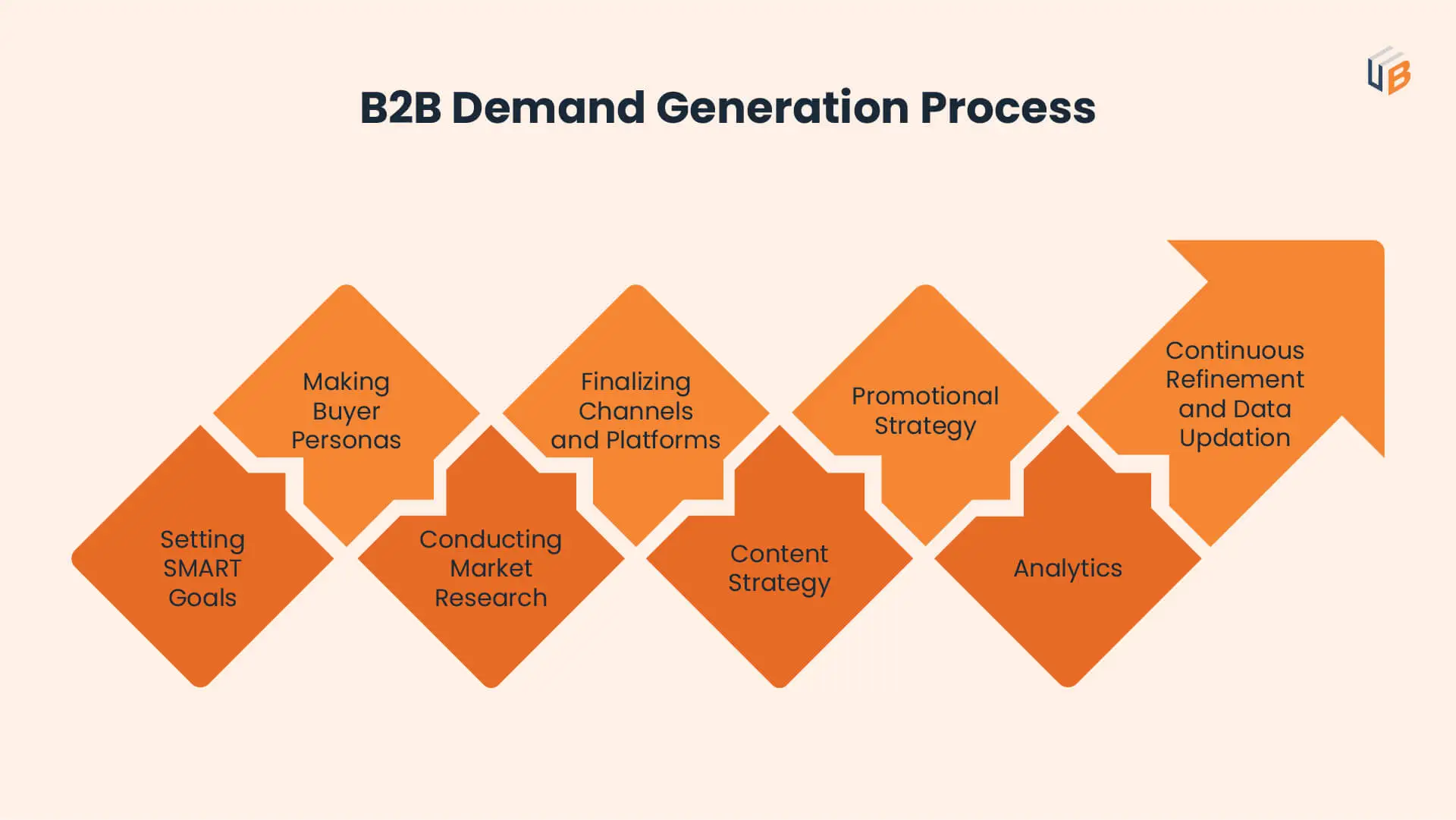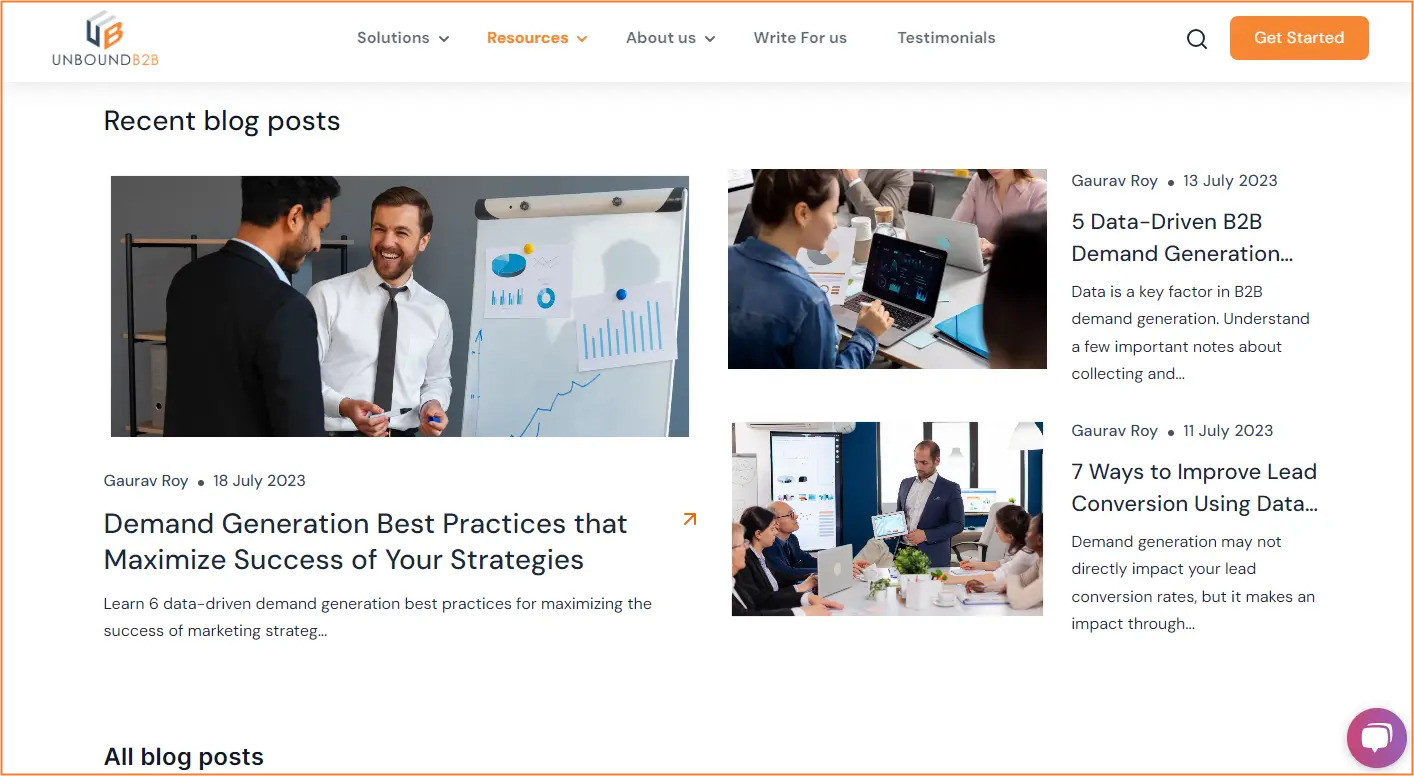
In 2024, data stands as the pivotal force driving B2B Demand Generation. Analyzing customer insights and behavior empowers you to precisely target your audience, personalize content, and optimize conversion funnels for maximum impact, yielding successful marketing campaigns.
But many marketers ask the question? How does data-driven demand generation differ from normal? In data-driven demand generation, you use data and analytics to gain deeper insights into customer behavior and preferences. By leveraging this valuable information, you can tailor your marketing strategies with precision. This helps you to effectively target specific audiences and optimize content delivery.
Such a data-centric approach not only increases the effectiveness of your campaigns but also allows for continuous improvement and adaptation. In turn, ensuring that you stay ahead in the competitive B2B landscape of 2024.
Keeping the same flow, there are several benefits you can experience through data-driven B2B demand generation.
Remarkable Benefits of a Data-Driven B2B Demand Generation Strategy
A data-driven demand generation strategy offers significant benefits for B2B companies in 2024.Few of them are mentioned below:
1. Customer-Centric Approach
Data-driven demand generation takes a customer-centric approach, leveraging valuable insights to understand the target audience deeply. Through data analysis, you can identify buyer personas, demographics, psychographics, and preferences. This eliminates speculation, as decisions are grounded in factual data. Analyzing the buyer’s journey helps pinpoint touchpoints, preferences, and pain points, providing a comprehensive view of their behavior.
2. Personalization Becomes the Theme
In 2024, generic marketing is outdated. Personalization strategy is crucial for effective demand generation. Data enables you to tailor content marketing and advertising strategies to match individual preferences. Personalized content resonates better with customers, driving higher engagement and action. Likewise, personalized advertising copy and design make ads more compelling. Acquiring and implementing data from market research becomes essential to achieve personalization throughout the demand generation strategy.
3. Attracting Better Leads That Convert More
Data-driven demand generation allows you to identify high-quality leads by analyzing various data points. Understanding the characteristics and behaviors of your best customers refines lead generation strategies. By focusing on prospects more likely to convert, you optimize resource allocation and improve overall conversion rates. Data-driven lead scoring helps prioritize efforts on leads with higher conversion likelihood.
4. Continuous Optimization for Better Results
Actively monitoring and analyzing real-time data during campaigns allows you to make necessary adjustments. Data-driven insights reveal opportunities for improvements before launching campaigns. Testing new approaches and optimizing marketing tactics based on data ensures relevance, effectiveness, and alignment with business goals. Staying updated with demand generation trends through data analysis allows you to adapt your strategy for immediate changes or modifications.
5. Data Analysis for Post-Purchase Satisfaction & Loyalty
B2B SaaS companies must focus on customer retention as much as acquisition. Data analysis of your customer base helps ensure customer satisfaction and loyalty. By collecting and analyzing data on customer usage and lifespan, you uncover insights for better user experiences. This not only retains existing customers but also provides valuable data to empower your sales team in acquiring new customers.
A data-driven demand generation strategy empowers B2B companies to understand their customers better, personalize their marketing efforts, attract and convert high-quality leads, continuously optimize campaigns, and foster post-purchase satisfaction and loyalty. Embracing data-driven practices leads to more effective demand generation, driving business growth and success in a competitive landscape.
What Does the Data-Driven B2B Demand Generation Process Look Like
When we talk about demand generation, there’s a lot that goes on at the same time, right?
Let’s make it look a little more streamlined and understand how the process looks. It will give you a visual representation of the start and continuous actions in demand generation.

Step 1: Setting SMART Goals
The demand generation process begins with setting specific, measurable, achievable, relevant, and time-bound (SMART) goals. These goals serve as the foundation of the entire strategy, providing clarity on what the marketing efforts aim to achieve. SMART goals may include increasing website traffic, generating a certain number of qualified leads, or boosting sales revenue within a defined timeframe.
Step 2: Making Buyer Personas
Creating detailed B2B buyer personas is crucial to understanding the target audience. Buyer personas are fictional representations of your ideal customers, encompassing demographics, motivations, pain points, and preferences. Knowing your audience intimately helps tailor marketing messages and content to resonate with their specific needs, increasing the effectiveness of demand generation efforts.
Step 3: Conducting Market Research
This is the most crucial step in data-driven B2B demand generation. Market research involves analyzing industry trends, customer behavior, and competitor strategies. Use data from various sources to identify gaps in the market, understand customer needs, and gain a competitive edge. Market research helps optimize the demand generation strategy by ensuring it is tailored to meet the changing demands of the target market.
Step 4. Finalizing Channels and Platforms
Based on market research and target audience preferences, identify the most suitable marketing channels and platforms to reach potential customers. This may include social media, search engines, email marketing, content marketing, webinars, events, or a combination of several channels. Selecting the right mix ensures maximum exposure to your target audience.
Step 5: Content Strategy
A well-defined content strategy is vital for data-driven B2B demand generation. Create valuable, relevant, and engaging content that aligns with buyer personas and addresses their pain points. The content should be distributed across chosen channels to attract prospects, nurture leads, and guide them through the buying journey.
Step 6: Promotional Strategy
The promotional strategy outlines how you will drive traffic and engagement to your content and marketing campaigns. It involves determining the frequency and timing of promotions, creating compelling ad copies, and leveraging various promotional tactics to increase visibility and engagement.
Step 7: Analytics
Integrate analytics tools to measure the performance of your demand generation efforts. Track key performance indicators (KPIs) such as website traffic, conversion rates, lead generation, and customer acquisition cost. Analyzing data enables you to identify successful strategies, optimize underperforming areas, and make data-driven decisions to improve results.
Step 8: Continuous Refinement and Data Updation
Data-driven B2B demand generation is an iterative process. Continuously monitor and refine your strategies based on real-time data and customer feedback. Stay updated with industry trends and adjust your tactics accordingly. Regularly update buyer personas to reflect changing customer preferences and behaviors.
These steps are not necessarily the only way to do data-driven demand generation. In fact, many demand generation strategies use this process as an outline to further expand on it as required. What are these strategies? Let’s explore some.
Data-Driven B2B Demand Generation Strategies to Implement in 2024
Data-driven demand generation strategies have become essential for companies aiming to attract and engage potential customers effectively. Here are five proven strategies that help you leverage data to optimize marketing efforts and drive success:
1. Paid Advertising & Remarketing
Utilize data to create targeted ads for service pages, landing pages, and resources. Detailed buyer information enables accurate targeting, while psychographic data enhances ad effectiveness. Data analysis identifies gaps and insights for campaign improvements, and remarketing campaigns re-engage interested users.
2. Dynamic Website Content
Personalize website content based on visitor behavior using data insights. Dynamic content displays personalized product recommendations, offers, and messages, captivating visitors and encouraging conversions. While it requires effort, the use of data ensures effectiveness and relevance.
3. Gated Resources and Lead Magnets
Data-driven gated resources and lead magnets help generate leads and identify intent signals. Valuable content and buyer information aid in crafting effective promotion strategies. Additionally, understanding buyer concerns helps focus on industry areas that require attention.
4. Email Campaigns and Automation
Leverage data for targeted email campaigns, nurturing leads effectively. Automated processes like welcome emails and asset downloads improve user experience and expedite lead progression through the funnel, leading to faster lead conversions.
5. Data-Driven Content Syndication
Enhance brand visibility through content syndication with data-backed platform choices. Track leads, monitor intent signals, and gather more intent data for further strategies, ensuring continuous optimization.
These strategies are amazing for businesses of all sizes to start with. However, it is important to remember that you can’t always do all of these. Sometimes, it’s better to stick a few rather than going all out and affecting the performance. But, there are some things that you need to remember, regardless of your strategies.
B2B Demand Generation Best Practices that Maximize the Success of Your Strategies
Data-driven B2B demand generation best practices are essential to drive success and connect with the right audience effectively. Whether you choose to implement strategies like content marketing, advertising, or email marketing, all of these should ideally follow practices like:
1. Using Reliable, Relevant, and Up-To-Date Data
Rely on accurate data to gain valuable customer insights, create targeted campaigns, and build trust with potential customers, all while staying ahead of the competition.
2. Implementing Conversion-Rate Optimization
Continuously analyze user behavior, conduct A/B testing, and optimize website elements to maximize conversions and enhance the return on investment from your demand generation efforts.
3. Voice Search Marketing
Optimize your content for voice search to tap into the growing audience using voice-enabled devices and virtual assistants, providing greater accessibility and relevance.
4. Customer-Centric Messaging and Personalization
Tailor your content and communication to address individual customer preferences, fostering stronger connections and driving demand for your products or services.
5. Data Management Standards and Compliance
Prioritize ethical data management and compliance to enhance customer trust, loyalty, and satisfaction, and to set your business apart as a reputable and reliable company.
6. Continuous Testing and Refining
Regularly test and evaluate various campaign elements to inform data-driven optimizations and refinements, ensuring maximum efficiency and demand generation success.
Those were some things that you should do. But what about the things you shouldn’t?
B2B Demand Generation Pitfalls You Need to Avoid
Data-driven B2B demand generation can go wrong in more ways than you can realize; Especially for marketing departments that are newly formed. To avoid these demand generation pitfalls, you need to be aware of them.
1. Not Organizing Marketing Data
To capitalize on the power of data-driven marketing, ensure your data is well-organized and reliable. Appoint a chief data officer, use CRM tools, and maintain data quality to unlock valuable insights that enhance your marketing campaigns.
2. Not Knowing Your Audience
Understanding your target audience is fundamental. Segment your customer data, invest in demand generation buyer personas, and utilize analytics tools to track user behavior and preferences for personalized marketing.
3. Not Using a Lead Scoring Approach
Implement lead scoring to identify highly qualified leads, tailor your marketing efforts, and improve conversion rates by focusing on prospects ready for the next steps.
4. Not Using Demand Generating Content Marketing Strategy
Create compelling content that triggers FOMO, incorporates user-generated content, partners with influencers, and delivers exclusive resources to attract and engage potential customers.
5. Not Offering Free Stuff
Provide enticing offers, free demos, or limited-time deals to engage your audience. Convert free users into paying customers by showcasing the value of your premium offerings.
6. Not Measuring Strategic Metrics
Monitor key marketing metrics like cost per acquisition, customer lifetime value, and click-through rate to evaluate campaign effectiveness and optimize strategies for maximum results.
7. Focusing on Too Many Things
Avoid spreading resources thinly across numerous marketing channels. Focus on high-converting strategies, continually monitor campaign performance, and invest where results are most promising.
B2B Demand Generation Strategy Examples and Case Studies to Take Inspiration From
Now that you know what to do and what not to, let’s see how some companies successfully do it. These examples and case studies will help you understand how to implement some of the B2B demand generation strategies discussed earlier.
1. UnboundB2B’s Content Marketing Strategy
UnboundB2B is a demand generation company that helps businesses with lead generation, ABM, and other demand generation services. We primarily target decision-makers in the B2B space. One of our primary targeting strategies is content marketing.

We identify our audience’s pain points and challenges based on intent signals and several other data factors. With our content marketing strategy, we try to solve some of those challenges by publishing valuable content in the form of blogs and resources like eBooks and case studies.
Since you’re interested in Data-driven demand generation, here’s an eBook about using Intent data to convert visitors into buyers.
2. Autodesk Using Webinars to Increase Demo Requests
Autodesk is a 3D design, engineering, and construction platform that used webinars as a demand generation strategy.
To get more demo requests for their product, Autodesk decided to organize a webinar for the topic “Top Workflows To Win More Bids in 2021”.
The webinar was basically meant to discuss cost-effectiveness, time-saving strategies, and increasing project win rates for more success in 2021.
The webinar’s goal was to get 700 entries, 200 attendees, and 50 demo requests for the product.
But, the results were even better;
- They had over 1,306 entries for the webinar
- About 340 people attended it
- 85 people requested for a demo
How did they get such an amazing result?
- Autodesk wanted to cross-sell with its existing customers. So, they included in-app messages and emails to existing customers and their prospects
- Autodesk also included a paid promotion strategy which brought in 15%-20% of the registrations
- Regular Social Media updates helped them keep the audience informed, but did not result in any registrations
3. Offer a Free Tool Like WordStream
Free tools are extensions for your existing product. You can include them to give your potential customers a taste of what using your main product could feel like.
WordStream did precisely that by introducing the Free Google Ads Performance Grader.
This tool audits your Google Ads account to grade your Ad performance with 17 key metrics.
LOCALiQ, the company that runs WordStream sells digital marketing services.
Having free tools like the Google Ads Performance Grader helps LOCALiQ’s target customers know the issues they’re facing. It also builds trust and lets those customers know that they can reach out to the company to solve those exact issues.
4. Semrush Using Twitter to Be a Part of Viral Conversations
Semrush is a B2B SaaS company that provides SEO tools.
The main issue Semrush faced was low brand recognition due to a saturated market. They wanted to stand out from the competitors.
Semrush turned to social media marketing to spread more brand awareness and show their unique personality to differentiate themselves.
One of the main platforms they focused on was Twitter. Social listening tools combined with industry-specific content, Semrush stayed active on trends and viral conversations.
This generated over 250,000 impressions and nearly 18,000 engagements within the first month.
B2B Demand Generation Trends and Its Future
2024 has already seen great advancements in terms of AI and technology that marketers use. And, some of the hottest demand generation trends right now are based on it. Some noteworthy trends include Voice Search Marketing which uses AI algorithms like Google Assistant, Alexa, Siri, and many others.
As far as the future of B2B demand generation is concerned, you should expect major changes regarding how we implement strategies. Various MarTech and AI solutions will improve our understanding of different markets and how to best target accounts in them.
If you want to stay ahead of the curve, you need a reliable demand generation partner. UnboundB2B is an established demand generation company that uses the latest and best in marketing to drive business growth across different verticals.
Our blog
Latest blog posts
Tool and strategies modern teams need to help their companies grow.

B2B companies must generate leads that are ready to buy their products in order to me...

In the absence of a constant flow of leads, sales teams can't meet their targets and ...

Podcasts and webinars are powerful tools that marketers can use to reach new audience...




